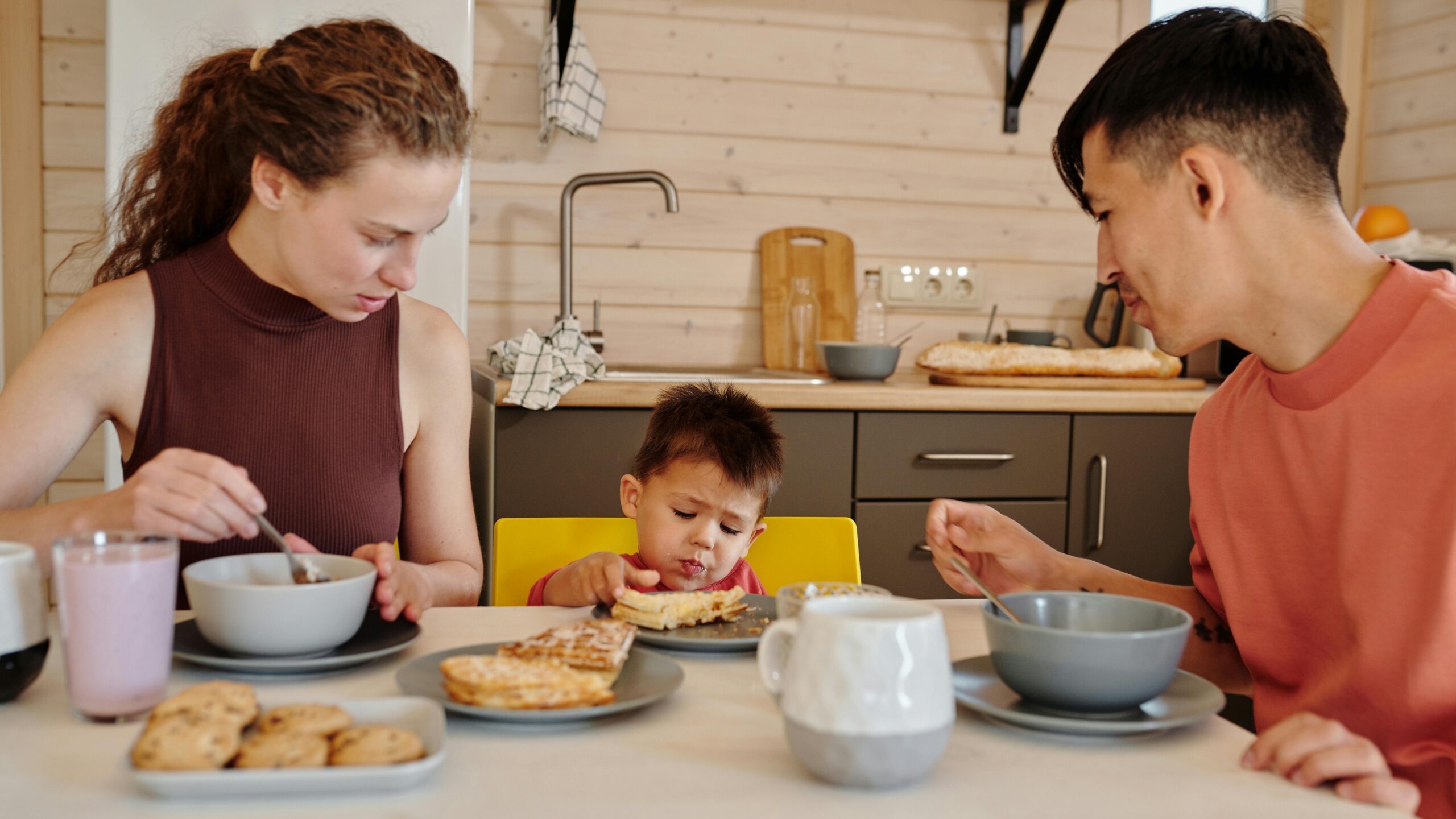
The Dinner Table Habit That Transformed Our Family
The Dinner Table Habit That Transformed Our Family
There was a Tuesday evening—unremarkable in every way—when I found myself staring at four people silently shoveling pasta into their mouths while scrolling, texting, and zoning out. My husband was answering work emails between bites. My teenage daughter had her phone propped against the water pitcher, watching someone’s dance video. My son was negotiating for dessert before he’d touched his broccoli. And I sat there, suddenly overwhelmed by a peculiar loneliness: we were all together, but completely alone.
If you’ve ever felt like your family shares a space but not a life—like you’re running a hotel restaurant instead of gathering around your own table—you’re not imagining things. The dinner table, once the sacred gathering place of family life, has become just another pit stop in our overscheduled days. But here’s the beautiful truth I discovered: one simple habit brought us back to each other, and it didn’t require Pinterest-perfect meals or an hour of prep time.
Why Family Dinners Feel So Hard (And Why They Matter More Than Ever)
Let’s be honest: getting everyone to the table at the same time feels like coordinating a corporate merger. Between soccer practice, late meetings, homework meltdowns, and the siren call of individual screens, family dinners have become an endangered species.
But here’s what the research tells us—and what I’ve witnessed in countless families I’ve worked with: according to a comprehensive study by Columbia University’s National Center on Addiction and Substance Abuse, teens who have frequent family dinners (five to seven per week) are significantly less likely to struggle with substance abuse, depression, and academic problems. They’re also more likely to report feeling close to their parents and having better relationships overall.
From a Family Systems Theory perspective, the dinner table is more than a place to eat—it’s where children learn they belong to something larger than themselves. It’s where communication patterns form, where emotional attunement happens naturally, and where kids absorb the unspoken message: “You matter enough for us to show up.”
The problem isn’t that we don’t know family dinners are important. It’s that we’ve made them too complicated, too perfect, too much. We think they need to look like a Norman Rockwell painting when really, they just need to be consistent and connected.
The One Habit That Changed Everything: The Question Basket
Here’s the beautifully simple practice that transformed our dinner table from a refueling station into the beating heart of our family life: the Question Basket.
In a small wicker basket that lives in the center of our table, we keep strips of paper with conversation-starting questions. Nothing fancy—just prompts that invite real stories, not one-word answers. Every dinner, someone picks a question, and we go around the table sharing.
The magic isn’t in the basket itself (though my kids did love decorating it). The magic is in what it does: it removes the pressure of forced conversation, gives everyone—even the quiet ones—something to say, and creates a predictable rhythm of connection that feels safe.
How to Build Your Own Connection Ritual
You don’t need my exact system. What matters is finding a simple, repeatable way to invite real conversation. Here are the tools that have worked for families I’ve guided through this process:
Start ridiculously small. If you’re currently eating separately in different rooms, don’t aim for seven dinners a week with phones in a basket and homemade sourdough. Try twice a week, fifteen minutes, whatever’s on the table. The goal is consistency over perfection. Your nervous system—and your child’s—needs the safety of predictability more than the pressure of perfection.
Create a no-rescue zone. This one’s counterintuitive but crucial: let there be silence sometimes. Let conversations meander or even flop. Not every dinner will feel like a Hallmark moment, and that’s exactly as it should be. When we rush to fill every silence or force cheerfulness, we teach our kids that authentic presence isn’t enough. Some of the most meaningful moments happen in the comfortable quiet between questions.
Invite contribution, not compliance. Let your kids help choose questions, set the table, or even decide on a silly dinner theme. When children have ownership over the ritual, they’re far more likely to engage. This isn’t about control—it’s about collaboration. Even your tiny CEO with the sippy cup can help decide whether tonight’s question comes from the “silly” pile or the “serious” one.
Make it screen-free (and that includes you). I know, I know—you need your phone for the recipe, or you’re expecting an important call. But here’s the truth: our kids are watching to see if they’re more important than the screen. Even ten minutes of fully present attention sends a message louder than a thousand “I love yous” said while scrolling.
End with a gratitude moment. This is where Positive Psychology meets real life. Before everyone scatters, take thirty seconds for each person to name one thing they’re grateful for from their day. It doesn’t have to be profound—”I’m grateful the cafeteria had pizza” absolutely counts. This practice gently rewires brains toward noticing the good, and it creates a positive emotional anchor for the entire dinner experience.
| Tool | What It Does | How to Try It |
|---|---|---|
| Question Basket | Removes pressure and invites authentic sharing | Fill a basket with conversation starters; one person picks each dinner |
| Start Small Commitment | Builds consistency without overwhelm | Choose 2-3 dinners per week; set a realistic time limit like 15-20 minutes |
| No-Rescue Zone | Teaches that authentic presence matters more than performance | Allow silence and natural conversation flow without forcing cheerfulness |
| Screen-Free Time | Shows kids they’re more important than notifications | All phones (including parents’) in another room or a basket during dinner |
| Gratitude Close | Rewires brains toward noticing positives; creates emotional safety | Each person shares one thing they’re grateful for before leaving the table |
Sample Questions to Get You Started
If you’re drawing a blank on what to put in your basket, here are some conversation starters that have sparked beautiful moments in families I’ve worked with:
- “If you could have any superpower for just one day, what would you do with it?”
- “What’s something that made you laugh today?”
- “If you could invite any person—dead or alive, real or fictional—to dinner, who would it be and what would you ask them?”
- “What’s one thing you’re looking forward to this week?”
- “Tell us about a time you felt really proud of yourself.”
- “What’s something you’d like to learn how to do?”
- “If our family was a team, what would be our superpower?”
Notice these questions don’t have right or wrong answers. They’re not quizzing anyone or putting anyone on the spot. They’re simply opening doors—and your kids get to choose which ones they walk through.
What Actually Happened When We Started
I won’t pretend it was magical from day one. The first week, my daughter rolled her eyes so hard I worried about her retinas. My son answered every question with “I don’t know” while sneaking glances at where his tablet usually sat. My husband and I felt awkward, like we were hosting a dinner party for people we’d just met.
But somewhere around week three, something shifted. My daughter picked a question and actually laughed at my husband’s answer. My son told a story about school without being prompted. We learned things about each other that never would have surfaced in our old pattern of “How was your day?” “Fine.”
The dinner table habit that transformed our family wasn’t about the food or even the questions, really. It was about creating a consistent space where showing up as ourselves—tired, goofy, frustrated, excited, whatever—was not just allowed but celebrated. It was about building a family culture where connection is the main course, and everything else is just sides.
Your Turn: Small Steps, Big Impact
You don’t need to overhaul your entire life or become a different kind of parent. You’ve already taken the hardest step—caring enough to imagine something better. Pick one small thing from this article to try this week. Maybe it’s just getting everyone to the table twice, phones away, for fifteen minutes. Maybe it’s writing five questions on scraps of paper and putting them in a coffee mug.
The transformation doesn’t happen because you do it perfectly. It happens because you keep showing up, keep creating space for connection, and trust that these small, consistent moments weave themselves into the fabric of who your family becomes. You’ve got this.



